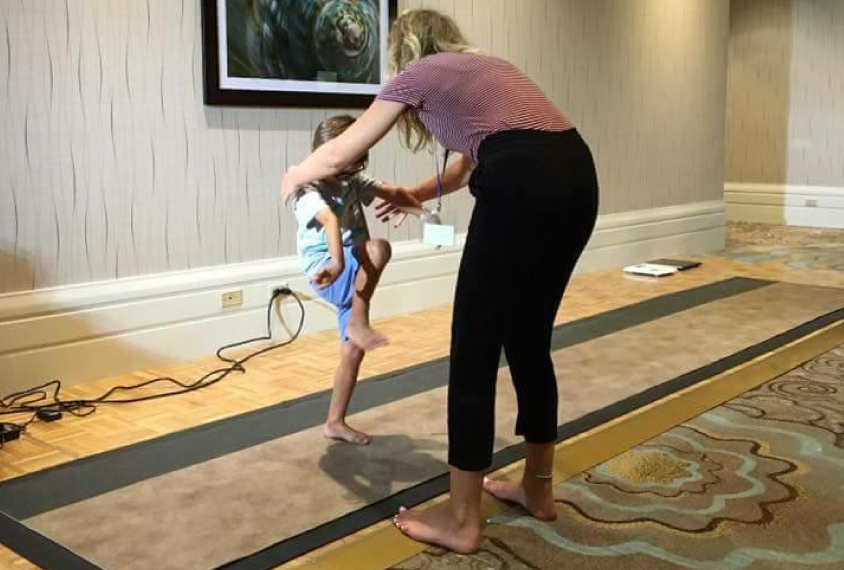
Mat with pressure sensors detects characteristic gait in dup15q syndrome
People with dup15q syndrome tend to walk slowly, have a wide stance and take short steps.
People with dup15q syndrome tend to walk more slowly, have a wider stance and take shorter steps than their typical peers do.
This gait pattern may be a biomarker of the syndrome and could be a target for treatment, says lead investigator Rujuta Bhatt, assistant professor of pediatrics and pediatric neurology at the University of California, Los Angeles. Bhatt presented the unpublished results Friday at the 2017 Dup15q Alliance Scientific Meeting in Los Angeles.
Bhatt and her colleagues collected most of the data at the alliance’s international family conference, also held in Los Angeles last week. They used a pressure-sensing floor mat to assess gait in 45 attendees with the syndrome and 10 of their typical siblings, and quickly analyzed the data.
“This is the largest cohort of children with dup15q syndrome,” Bhatt says.
Movement difficulties are common among people with dup15q syndrome, a condition closely related to autism. Up to 80 percent of children with autism also have trouble with balance and are clumsy. The exact nature of motor problems can vary from person to person, but overall, such problems contribute to difficulties with communication and daily-living tasks.
One way scientists can measure children’s motor abilities is by using a standardized test called the Movement Assessment Battery for Children. The test assesses a child’s performance on tasks such as threading beads on a string or tracing a picture.
Modified tests:
However, most children with dup15q syndrome score low on this test because they either cannot attend to the tasks long enough to complete them, can’t finish them in the allotted time or can’t do them at all because they don’t understand the instructions, says Bhatt.
Bhatt and her colleagues are trying to modify the tasks so that the children can complete them. They have also sought measures that are quantitative or provide qualitative information about motor abilities beyond simple motor tests.
A 2014 study of mice provided inspiration. In that study, researchers at the University of Chicago used an automated gait-tracking system to measure footstep patterns in a mouse model of dup15q syndrome. The study found that the mutant mice walk more slowly and have a wider stance and shorter stride length than control mice do1.
Bhatt acquired a similar device that can track walking patterns in people: a floor mat equipped with pressure sensors that tracks footstep patterns as people walk across it. She has since measured the walking patterns of 10 children with dup15q syndrome who visited her clinic.
Last Monday, Bhatt temporarily installed a mat at the family meeting. Bhatt’s team collected data from the 55 participants, ranging in age from 3 to 41 years.
“The families were very happy that it took little instruction and minimal time to rapidly obtain the gait data,” Bhatt says. “Parents noted that their children were excited to walk on the mat and see their footsteps on the computer.”
Fancy footwork:
Footstep patterns in the typical siblings vary little, and their feet consistently apply pressure from heel to toe, Bhatt’s team found. By contrast, people with the syndrome have a large distance between their feet and tend to distribute less pressure along the entire length of the foot; they also appear to waddle from side to side.
These gait patterns bear a striking resemblance to those seen in the mouse model of the syndrome, says Sarah Spence, assistant professor of neurology at Harvard Medical School, who was not involved in the study. That suggests that studying the mice can help researchers understand the neural mechanisms underlying the unusual gait.
The ease with which the researchers appear to be able to collect data on motor function is an important advance for the field, Spence says. “One thing we have not done very well or thoroughly is investigate motor functioning, and the reason is because we didn’t have good measures,” she says. “Having a quantifiable motor measure that’s super easy to collect the data on is remarkable.”
Bhatt and her colleagues have also devised a way to use the mat to measure balance and stability. Traditional measures of balance require people to stand on one foot for up to at least 30 seconds, or to climb onto a balance board. Both of these tasks are difficult for people with dup15q syndrome.
In the task that Bhatt’s team developed, by contrast, participants simply stand in place on the mat and lift one foot for a few seconds. The mat measures the area and length in which the standing foot applies pressure, providing a measure of stability. The larger the area and length, the less stable the individual. Individuals with dup15q syndrome tend to have a larger area and length than controls do, suggesting they are less stable.
Bhatt says she would like to use the system to measure the walking patterns of people with other syndromes related to autism.
For more reports from the 2017 Dup15q Alliance Scientific Meeting, please click here.
References:
- Piochon C. et al. Nat. Commun. 5, 5586 (2014) PubMed
Recommended reading

Documenting decades of autism prevalence; and more

Expediting clinical trials for profound autism: Q&A with Matthew State
Explore more from The Transmitter

‘Perturb and record’ optogenetics probe aims precision spotlight at brain structures


